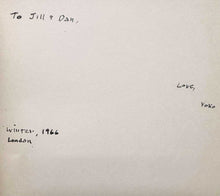
ONO, Yoko. Grapefruit. ONO, Yoko. Grapefruit. Tokyo: Wunternaum Press. 1964.
Square 8vo (14 x 14 cm). White card wrappers lettered in black to the inner margin of front panel, housed in a folding chemise inside a box, both in white cloth, the box lettered in black to the spine; unpaginated, c. 350 pages; light circular marks to front panel (diameter c. 4 cm), light rubbing and scattered marks front and rear, spine naturally and evenly creased, remaining firm, one page detached but snugly in place, text block lightly toned, lower edge with a few marks, inner hinge splitting but holding; author’s inscription in black ink to preliminary blank page.
An inscribed first edition (one of 500 copies) of Yoko Ono’s magnum opus: a touchstone for the Fluxus movement, and a talismanic work for John Lennon. An association copy, inscribed to Jill and Daniel Richter, friends, associates and assistants to Ono and Lennon.
The significance of this compact little volume belies its modest appearance. Issued in an edition of 500 copies on July 4, 1964 while Ono was living in Tokyo with her second husband Anthony Cox, Grapefruit, described most simply, is a collection of short instructions or “event scores” (in English and Japanese), which the reader may choose to follow – in practice or imagination – or simply read. The idea of an event score was a product of John Cage's Experimental Music Composition classes, which Ono’s first husband, Ichiyanagi Toshi, had attended. The title of the book was chosen because Ono saw the grapefruit, a hybrid genus derived from the sweet orange and the pomelo, as analogous to her own status as a hybrid of Japanese and American cultures (Ono grew up in Tokyo, moving to New York in 1952). The book, too, is a hybrid thing, its fusion of text, image, and invitations to performance famously, and sometimes infuriatingly, difficult to pin down.
The texts are dedicated to a star-studded cast of friends, fellow artists and musicians including Cage, David Tudor, Nam June Paik, La Monte Young, Peggy Guggenheim, and Yuji Takahashi. Within each of its five parts (Music, Painting, Event, Poetry, and Object), each entry is dated by a season and year from the 1950s and 60s, the content (loosely) appropriate to its respective section. The “pieces” in Music, for example, are focused primarily on the production of, or attention to, sound (WATER PIECE, 1963 spring, instructs the reader to “Listen to the sound of the underground water”, while LAUGH PIECE (1961winter) consists of the exhortation to “Keep laughing a week”). And so on for the remaining sections: Painting (PAINTING FOR WIND, 1961 summer, “Cut a hole. Cover with fine bamboo screen. Place it in the wind”); Events (LIGHTING PIECE, 1955 autumn, “Light a match and watch till it goes out.”); Poetry
(TOUCH POEM FOR GROUP OF PEOPLE, 1963 winter, “Touch eachother” [sic]); Object (HOROSCOPE PIECE, 1964 spring, “Make a sculpture to put on a mountain for people to see with horoscopes.”) Some are clearly more practically feasible than others and, as Ono explained in 1971, “[t]o understand the pieces, you must do them. Even doing them in your mind is making a step part of the way
along the road to better communication with yourself.”
By the time Grapefruit was reprinted in 1970, Ono was married to John Lennon. They met in 1966 (the winter of Ono’s inscription for this copy of the first edition) and married in 1969. Lennon provided a thirteen-word introduction for the new edition – “Hi! My name is John Lennon/ I'd like you to meet Yoko Ono” – immediately followed by Ono’s “Theatre Piece (1968 spring), JOHN LENNON AS A YOUNG CLOUD”. She had sent Lennon a copy of Grapefruit shortly after their first meeting and, by all accounts, the book became something of a talisman for him. Ono's “Cloud Piece” (“Imagine the clouds dripping. / Dig a hole in your garden to / put them in.”) was reproduced on the back cover of the album, Imagine (1971). The title track of the album is credited to Lennon alone, but he later he conceded that it “should be credited as a Lennon/Ono song. A lot of the lyric and the concept came from Yoko, but in those days, I was a bit more selfish, a bit more macho, and I sort of omitted her contribution, but it was right out of Grapefruit.”
This copy of the first edition is inscribed “To Jill & Dan [Richter], / love, / Yoko / Winter, 1966 /London”, the layout of the inscription and date pleasingly redolent of the printed entries in the book. Daniel Richter (b.1939) was an American mime artist (he played the “Moonwatcher” ape in Stanley Kubrick's 2001) who met Ono in Tokyo in 1964 while studying traditional Japanese theatre. He edited the underground poetry magazine Residu with his wife, and fellow dedicatee, Jill. Both were close to Ono as her relationship with Lennon developed, and lived with John and Yoko at their home at Tittenhurst Park for several years as friends and personal assistants (Daniel Richter appears in the 1972 film, Imagine, shot at Tittenhurst).
#2121242







